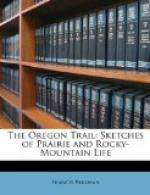hungry. A wooden bowl was soon set before me,
filled with the nutritious preparation of dried meat
called pemmican by the northern voyagers and wasna
by the Dakota. Taking a handful to break my fast
upon, I left the lodge just in time to see the last
band of hunters disappear over the ridge of the neighboring
hill. I mounted Pauline and galloped in pursuit,
riding rather by the balance than by any muscular
strength that remained to me. From the top of
the hill I could overlook a wide extent of desolate
and unbroken prairie, over which, far and near, little
parties of naked horsemen were rapidly passing.
I soon came up to the nearest, and we had not ridden
a mile before all were united into one large and compact
body. All was haste and eagerness. Each
hunter was whipping on his horse, as if anxious to
be the first to reach the game. In such movements
among the Indians this is always more or less the
case; but it was especially so in the present instance,
because the head chief of the village was absent,
and there were but few “soldiers,” a sort
of Indian police, who among their other functions
usually assumed the direction of a buffalo hunt.
No man turned to the right hand or to the left.
We rode at a swift canter straight forward, uphill
and downhill, and through the stiff, obstinate growth
of the endless wild-sage bushes. For an hour and
a half the same red shoulders, the same long black
hair rose and fell with the motion of the horses before
me. Very little was said, though once I observed
an old man severely reproving Raymond for having left
his rifle behind him, when there was some probability
of encountering an enemy before the day was over.
As we galloped across a plain thickly set with sagebushes,
the foremost riders vanished suddenly from sight, as
if diving into the earth. The arid soil was cracked
into a deep ravine. Down we all went in succession
and galloped in a line along the bottom, until we
found a point where, one by one, the horses could scramble
out. Soon after we came upon a wide shallow stream,
and as we rode swiftly over the hard sand-beds and
through the thin sheets of rippling water, many of
the savage horsemen threw themselves to the ground,
knelt on the sand, snatched a hasty draught, and leaping
back again to their seats, galloped on again as before.
Meanwhile scouts kept in advance of the party; and now we began to see them on the ridge of the hills, waving their robes in token that buffalo were visible. These however proved to be nothing more than old straggling bulls, feeding upon the neighboring plains, who would stare for a moment at the hostile array and then gallop clumsily off. At length we could discern several of these scouts making their signals to us at once; no longer waving their robes boldly from the top of the hill, but standing lower down, so that they could not be seen from the plains beyond. Game worth pursuing had evidently been discovered. The excited Indians now urged forward their tired horses even more




